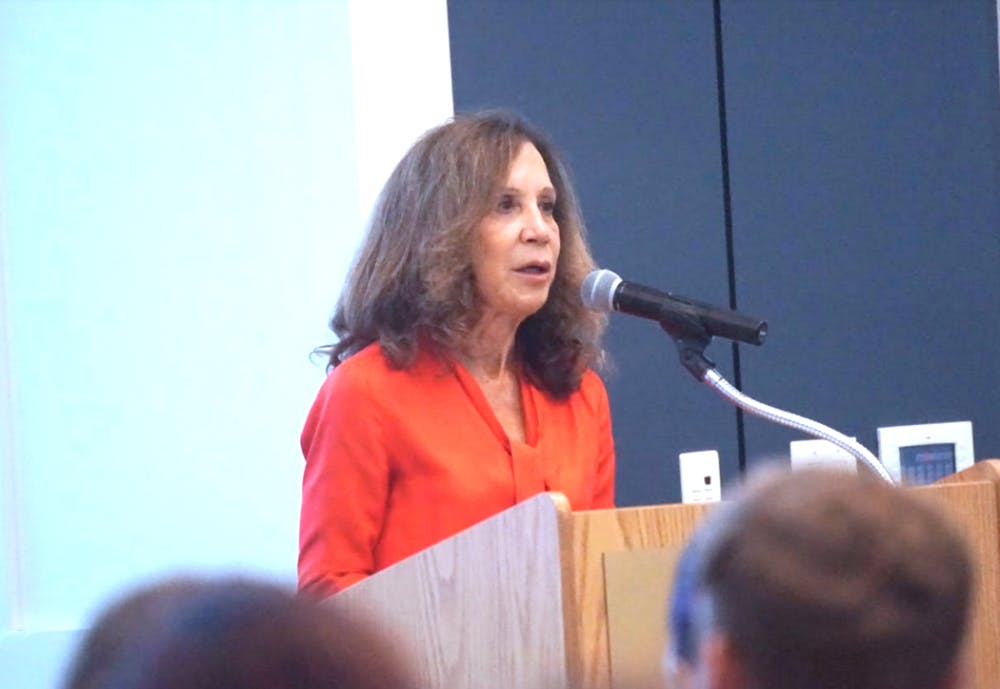By Ariel Steinsaltz
Staff Writer
In the first installment of the colloquium series, “Plague, Progress, and Prevention: 100 Years after the ‘Spanish Flu’ Changed the World,” the School of Science held a presentation titled “The Great Epidemic, 100 Years Later,” on Sept. 25 in the Education Building Room 212.
Gina Kolata, a reporter for The New York Times and author of “Flu: The Story Of The Great Influenza Pandemic of 1918 and the Search for the Virus that Caused It,” explained the story of how the specific strain of flu responsible for the 1918 outbreak was uncovered and recreated nearly a century after the deadly pandemic devastated the world.

The driving force behind organizing the event was Rita King, an adjunct faculty member in the biology department.
According to King, the lecture was timed to be presented around the 100th anniversary of the Spanish flu pandemic. King studies emerging and re-emerging infectious diseases, and personal ties to the flu ––– her grandfather succumbed to the disease after being ill for just one week.
Kolata described the flu strain as a masked murderer who, around 100 years ago, was never brought to justice. The flu pandemic of 1918, known as the Spanish flu, killed more people than both World Wars, the Korean war and the Vietnam war combined, according to Kolata.
Kolata further explained that unlike most flu viruses, which commonly infect children, the weak and the elderly, the Spanish flu instead attacked young, healthy people. After the virus wreaked havoc on the world and brought the life expectancy in the U.S. down from 51 to 39, the virus mysteriously disappeared. Nobody was able to find a living sample or determine its makeup, according to Kolata.
The story of the discovery of the Spanish flu virus involves three of its victims: a 21-year-old private named Roscoe Vaughan, a 30-year-old soldier named James Down and an obese woman from a remote Alaskan village.
Vaughan was the first of the three to die. He died at a training camp on Sept. 26, 1918, with his chest cavity full of fluid. The doctor who autopsied him sent a sample of his lung, sealed in candle wax, to the Armed Forces Institute of Pathology, a medical repository for military deaths started by Abraham Lincoln.
Downs died later the same day in Camp Upton, New York, and his doctor also sent a lung sample to the Institute.
When the flu reached the remote Alaskan village where the third victim lived, it killed 72 of roughly 80 adults in the village and orphaned many children. The victims were buried in a frozen mass grave.
The flu epidemic then ended, with millions dead. For decades, it was rarely discussed.
In 1950, the story resumed when a Swedish medical student in Iowa named Johan Hultin heard that a famous biologist his department give advice on how to find the Spanish flu virus –– people should go north and find the bodies buried in the Alaskan permafrost.
Hultin, having recently been to Alaska, knew somebody who knew the locations of such graves. He found the village where the obese woman lived and convinced the local elders to let him dig up bodies. He found samples of the virus, and tried to insert them into chicken eggs and then animals, but failed, assuming that the virus was dead.
The flu again went unnoticed for decades.
In 1995, Jeff Taubenberger, a member of the Armed Forces Institute of Pathology, decided that he was going to try to rediscover the 1918 flu strain. Despite the odds against him, he managed to find Vaughn’s DNA sequence that had been sent to the repository in the midst of World War I.
He then published a paper, and got another strain of evidence from Downs’ body, but he still did not have enough information to make a claim about the virus’ whereabouts.
Hultin, after reading Taubenberger’s paper, told the researcher about the Alaskan village. Hultin went to the village’s mass grave and found the body of the obese woman.
According to Kolata, the woman was the only victim whose body had not fully decomposed. He put samples of her lungs in the mail and Taubenberger received them, confirming that the virus he had seen in the soldiers was indeed the 1918 Spanish flu.
Since this discovery, Taubenberger has been working on a vaccine to cure every strain of the flu. Many questions about the flu remain unanswered –– why did it target the young and healthy? Why were many children left untouched?
Regardless of remaining loose ends, Kolata acknowledges how far researchers have come.
“This was an amazing accomplishment,” she said. “It’s hard to believe that scientists could find the 1918 flu when it had been gone from the Earth for over 50 years.”
Lexy O’Neill, a senior nursing major, attended the event to learn about King’s work.
“I got a lot of good information that I didn’t know,” O’Neill said. “I had no idea that they had reconstructed the flu virus, that it was a completely ignored topic.”
Fortunately, the risk of the virus claiming lives in modern times remains low — Kolata explained that the flu’s effects would not be as devastating if it returned, because the population today is generally healthier than 100 years ago.







